I am trying to run a lavaan structural equation model to identify change between two time points.
I have the following data set:
structure(list(COG_T1 = c(0.0010333, 0.00105981, 0.00113736,
0.001108715, 0.00104864, 0.00110772, 0.00109096, 0.00109855,
0.00104169, 0.00112465, 0.001096525, 0.000985059, 0.001098955,
0.001069465, 0.00105376, 0.00106878, 0.00110388, 0.00108702,
0.001162835, 0.001070955, 0.0010971, 0.00111695, 0.001060525,
0.00108797, 0.00103262, 0.001117605, 0.001061707, 0.001156365,
0.00104431, 0.00109114, 0.001053765, 0.001045395, 0.00106441,
0.00108481, 0.0011145, 0.001095115, 0.001099075, 0.001057, 0.001096125,
0.00109696, 0.001064795, 0.00108024, 0.00102137, 0.001103185,
0.00111948, 0.001110965, 0.00103784, 0.00104419, 0.00101302,
0.00108785, 0.001098765, 0.001052415, 0.0010976, 0.001064385,
0.001129705, 0.001076575, 0.001049785, 0.00103181, 0.001078155,
0.001129015, 0.001024814, 0.00109171, 0.001007862, 0.001099885,
0.00109162, 0.001060665, 0.00106572, 0.00106803, 0.00113409,
0.001052505, 0.001138575, 0.00108723, 0.001046765, 0.001090765
), COG_T2 = c(0.00106309, 0.00106822, 0.001052205, 0.001106125,
0.001060125, 0.00106945, 0.001092695, 0.00107696, 0.001063425,
0.001116725, 0.00105891, 0.001054205, 0.00109295, 0.00109387,
0.00101807, 0.001066195, 0.001120295, 0.001111565, 0.001088595,
0.00102183, 0.0010934, 0.00111935, 0.00105371, 0.00108314, 0.0011006,
0.001079585, 0.001127775, 0.001140825, 0.00106203, 0.001118035,
0.00103535, 0.00099512, 0.001078955, 0.00108867, 0.0010789, 0.001030445,
0.00106243, 0.001028545, 0.00108679, 0.00105624, 0.001110145,
0.00107318, 0.00106523, 0.001103515, 0.00112404, 0.001064455,
0.001040425, 0.001059305, 0.00106362, 0.001079395, 0.00107183,
0.0010652, 0.00106983, 0.00111722, 0.00114111, 0.001059649, 0.001029902,
0.001062825, 0.001102155, 0.001122135, 0.00103623, 0.00108648,
0.001081035, 0.001110075, 0.001039397, 0.001057715, 0.0010338,
0.001071455, 0.001072065, 0.001032233, 0.00111996, 0.00106407,
0.0010693, 0.001104395)), class = "data.frame", row.names = c(NA,
-74L))
plotted:
library(lavaan)
library(tidyverse)
id <- factor(1:length(DF$COG_T1))
plotdattemp <- data.frame(DF$COG_T1, DF$COG_T2, id) #create dataframe with raw scores
plotdattemp %>%
reshape2::melt(by = "id") %>%
ggplot(aes(x= variable, y= value)) +
geom_point() +
geom_line(aes(group = id))
Model fit:
#Fit the Univariate Latent Change Score model
ULCS_DF<-'
COG_T2 ~ 1*COG_T1 # Fixed regression of COG_T2 on COG_T1
dCOG1 =~ 1*COG_T2 # Fixed regression of dCOG1 on COG_T2
COG_T2 ~ 0*1 # This line constrains the intercept of COG_T2 to 0
COG_T2 ~~ 0*COG_T2 # This fixes the variance of the COG_T2 to 0
dCOG1 ~ 1 # This estimates the intercept of the change scores
COG_T1 ~ 1 # This estimates the intercept of COG_T1
dCOG1 ~~ dCOG1 # This estimates the variance of the change scores
COG_T1 ~~ COG_T1 # This estimates the variance of COG_T1
dCOG1~COG_T1 # This estimates the self-feedback parameter
'
fitULCS <- lavaan(ULCS_DF, data=DF, estimator='mlr', fixed.x=FALSE, missing='fiml')
summary(ULCS_DF, fit.measures=TRUE, standardized=TRUE, rsquare=TRUE)
But I am getting the following warnings:
Warning messages:
1: In lav_mvnorm_missing_h1_estimate_moments(Y = X[[g]], wt = WT[[g]], :
lavaan WARNING:
The smallest eigenvalue of the EM estimated variance-covariance
matrix (Sigma) is smaller than 1e-05; this may cause numerical
instabilities; interpret the results with caution.
Since the values are too small:
- How can I work around this? Should I be scaling the data around 0?
